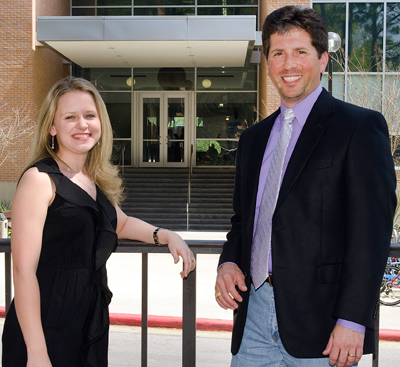Inaugural Survey Reveals Needs, Attitudes Of Texas's Rural Citizenry
April 23, 2013
SHSU Media Contact: Jennifer Gauntt
 |
| Center for Rural Studies associate director Cheryl Hudec and director Gene Theodori, along with a team of researchers from SHSU's sociology department, conducted last year's inaugural Texas Rural Survey to assess the attitudes and needs to Texans living in small communities. They will begin working on a second survey this summer. —Photo by Brian Blalock |
Texans living in rural areas may have less access to quality amenities and services but those citizens are, overall, happy in their communities, according to researchers in Sam Houston State University’s Center for Rural Studies.
The team of sociologists analyzed responses from 4,111 households in 22 rural communities across the state for the inaugural Texas Rural Survey, the results of which were recently released.
Respondents were asked about a variety of social and economic topics ranging from community and economic development, local services and amenities, access to medical and healthcare services to education, workforce development, agriculture and disaster preparedness.
“In Texas, rural people and communities face certain challenges that differ from their urban and suburban counterparts,” said Cheryl Hudec, associate director for the Center for Rural Studies. “Nearly 3.8 million people live in rural areas throughout the Lone Star State. In other words, the population of rural Texas is greater than or roughly equal to the resident populations of 24 other individual states.”
Among the findings, both availability and quality of healthcare services and providers within the community were of great concern for rural residents, with about 90 percent of respondents stating that there were better quality medical doctors outside of their community and more than 70 percent of respondents felt they needed more primary doctors within their community.
Responses to inquiries about public amenities and services were mixed, with citizens largely being satisfied with such things as religious services, fire protection, public schools, library services, water service provider, and sewage/waste disposal; and largely dissatisfied with the availability of mental health services, streets and roads, arts/cultural activities, retail shopping, entertainment and public transportation.
In addition, those surveyed were asked to rank 35 proposed issues that could be perceived as community problems, and findings indicated that while the quality of schools, pollution and fire protection were not perceived as problems, the top 12 most serious issues reported included the use of illegal drugs, availability of good jobs, public transportation, lack of commercial development, poverty, lack of industrial development, conditions of streets and roads, recruitment/retention of health care professionals, outmigration of youth, increased aging of the population, availability of medical and healthcare services and affordable housing.
Economic strategies within each surveyed community also rendered varying results, this time among city leaders and the general population.
While almost 73 percent of city leaders believed the promotion of tourism in rural Texas should be given the highest priority from the state when it comes to fostering economic development in rural areas, citizens believed there should be a focus on the community’s resources.
Almost 68 percent of the general population gave “high priority” to promoting Texas oil and natural gas development and almost 67 percent to promoting Texas agricultural products.
Finally, with the damage from the 2011 Texas wildfires and several hurricanes that have affected the state still on people’s minds, surveyors measured citizen response to natural disasters, which revealed some “unexpected findings,” according to Hudec.
“Concern for drought is widespread in rural Texas,” Hudec said, adding that about 84 percent listed drought as a concern above any other natural hazard. “Even in areas that lacked historical experiences with drought, residents still indicated high levels of concern for this hazard type.
“(On the other hand) Residents living in areas with a history of floods indicated relatively low concern about future flooding,” she said.
Researchers followed this with questions on perceptions of community preparedness in the event of a natural disaster, where residents expressed an uncertainty about their community’s ability to respond.
“Thirty-six percent of rural residents indicated that their area did not have an emergency management plan,” Hudec said. “However, verification with county officials confirmed that all counties where these respondents reside do have emergency management plans.
“The revelation that most rural residents are not aware of these plans indicates a pressing need to inform rural residents about their community’s disaster preparedness and include them in emergency preparedness initiatives,” she said.
The Texas Rural Survey was conducted last summer, and results were analyzed throughout the fall and early spring semesters. The center will conduct its second survey this summer.
Because of the vast number of people who live in rural Texas, understanding the results of this survey is important politically and economically, according to Hudec.
“Between 2000 and 2010, 39 percent of the nonmetropolitan counties in Texas lost population,” she said. “Further, nonmetropolitan counties within Texas maintain, on average, lower per capita incomes, higher poverty rates, greater levels of aged-dependency ratios with fewer workers to support those over age 65, and lower labor force participation rates than do urban areas.
“U.S. Census Bureau data affirm that Texas residents living in nonmetropolitan counties are older, less educated, and poorer than their metropolitan counterparts,” she said. “In addition, the quantity and quality of many amenities and public services are frequently inadequate to meet the needs of rural Texans. Pressing needs exist for job creation, increased incomes, economic growth, modernization, improved service delivery, and business recruitment, retention and expansion activities.
“Understanding rural Texas areas and the perceptions of individuals living in these communities is critical to guiding future development efforts and strategies, along with understanding the different needs of rural communities.”
The complete report can be found online at http://www.shsu.edu/~org_crs/txruralsurvey.html.
- END -
This page maintained by SHSU's Communications Office
Associate Director: Julia May
Manager: Jennifer Gauntt
Located in the 115 Administration Building
Telephone: 936.294.1836; Fax: 936.294.1834
Please send comments, corrections, news tips to Today@Sam.edu.

 SamWeb
SamWeb My Sam
My Sam E-mail
E-mail

